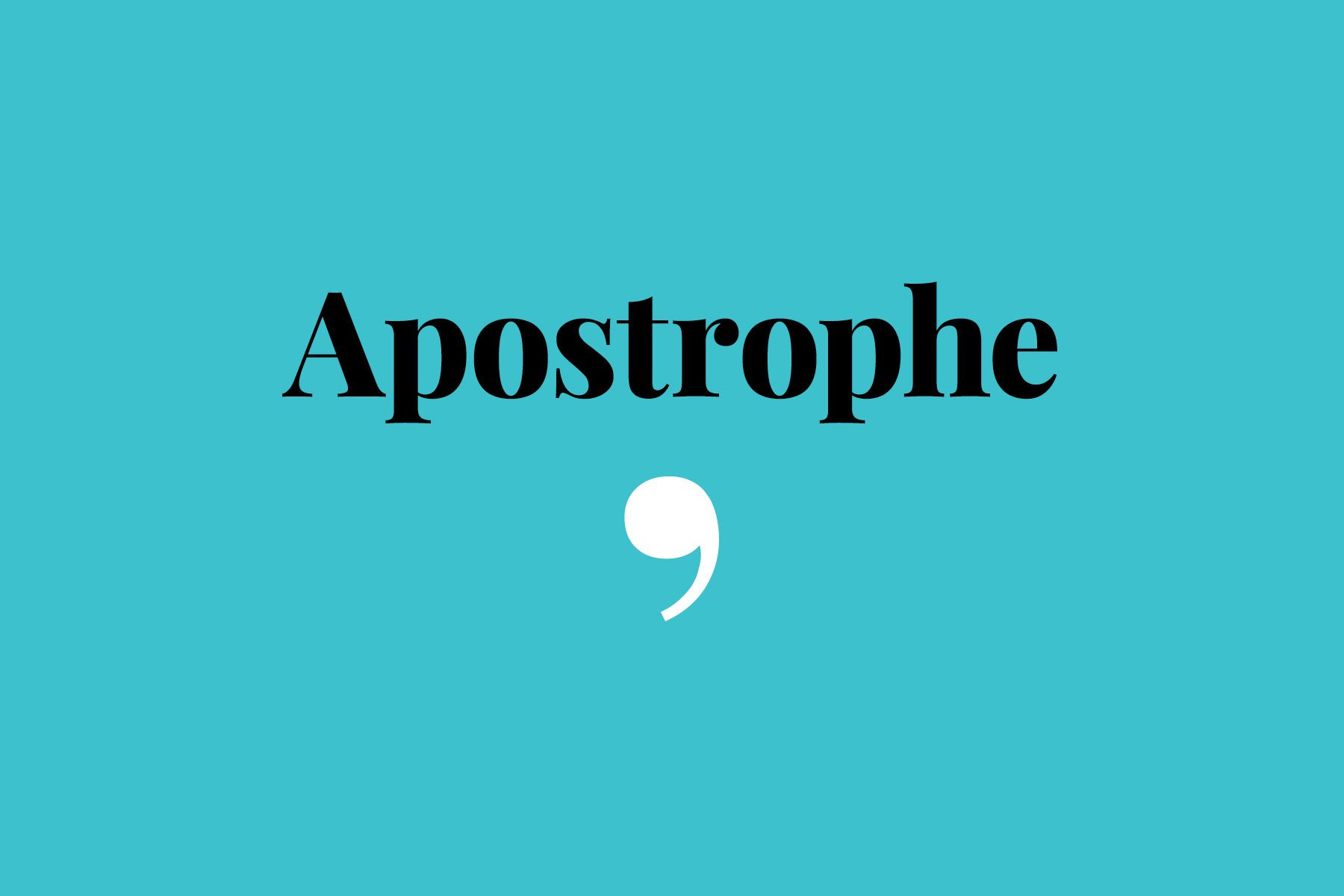An apostrophe is not an accessory. Here are some easy-to-follow rules for using an apostrophe—and when you definitely shouldn't.

Simple Rules for Using an Apostrophe the Right Way

If you’ve ever been stuck between its and it’s or wondered how to make a last name ending in s possessive, you’re not alone. The rules for using apostrophes can be challenging, even for seasoned writers. But they’re well worth learning.
An apostrophe might be tiny, but used correctly, it adds clarity and polish to your writing. Written communication would be chaos without proper punctuation! And a poorly placed apostrophe just adds to the confusion. The little character can break the flow or meaning of a sentence if you’re not careful.
Knowing when to use an apostrophe may be one of the most confusing grammar rules, but once you learn the basics, your writing will be a whole lot clearer. To help you understand the rules for using apostrophes, we’re breaking down the concept into simple, everyday examples. So whether you’re tackling contractions, showing ownership or navigating common mistakes with compound nouns, look at this as your go-to guide to apostrophes.
Read on for the only apostrophe primer you’ll need.
Get Reader’s Digest’s Read Up newsletter for more grammar, humor, tech and fun facts all week long.
What is an apostrophe?
Apostrophes are the curly, floating commas in sentences that usually indicate possession or a contraction. For example, we use apostrophes to write possessive words like man’s, Nan’s and plan’s, plus contractions like can’t, won’t, don’t and shouldn’t.
What are the rules for using apostrophes?

The first rule of using an apostrophe? Remember that you’re not making a word plural. Once you’ve conquered that common grammar flub, you’re ready to dive into the various ways you can use apostrophes in your writing.
Combining words
Contractions, or shortened groups of words, use the apostrophe to replace the missing letters. For example, if you want to connect do and not, you can use an apostrophe to replace the second o, making the new word don’t. Such omissions make words and sentences not only easier to read but also to write. And contractions tend to sound more casual, making them more common in modern writing.
Examples:
- Do not to don’t: “I don’t understand all these confusing grammar rules.”
- Is not to isn’t: “That isn’t my car.”
- They are to they’re: “They’re going to the movies tonight.”
- Of the clock to o’clock: It’s 5 o’clock.
Other common words that are often combined include did not (into didn’t), are not (into aren’t) and had not (into hadn’t). One exception to the pattern should stand out right away as an incorrect contraction: Will not doesn’t become willn’t! It’s won’t.
Showing ownership or possession
One of the apostrophe’s key functions is to let readers know that an object belongs to a noun. Sure, you could say “the house belonging to the woman,” but that stilted phrasing will likely get you more eyebrow raises than understanding nods. Instead, most people form a possessive: the woman’s house.
But as with most elements of grammar, it’s not as easy as slapping an ’s after everything. Keep reading for specific rules for using apostrophes in possessives.
Singular nouns not ending in s
For singular nouns that don’t end in an s, you add an apostrophe and an s to make it possessive, showing ownership.
Examples:
- The cat’s litter box
- The child’s toy
- Harry’s girlfriend
Plural nouns not ending in s
Like singular nouns that don’t end in s, plural nouns not ending in s gain both an apostrophe and an s when they become possessive.
Examples:
- The children’s toys
- The women’s party
- The mice’s tails
Singular nouns ending in s
When the word (or name) you’re making possessive is singular but ends in s, things get a bit confusing—so much so that even grammar experts and style guides disagree on the rules for using apostrophes when pluralizing words ending in s.
You have two options here:
- Add only an apostrophe
- Add both an apostrophe and an s
Some writers and editors suggest adding an apostrophe and an s if, when saying the word out loud, you would pronounce the extra s. So you would write “The walrus’s tusks were huge” and “The bus’s wheels went ’round and ’round.”
But sometimes you don’t say the s, in which case you’d use only the apostrophe. You’d share your opinions on Charles Dickens’ novels—not Charles Dickens’s novels—because you wouldn’t say “Dickenses” out loud.
Here at Reader’s Digest, we follow the Associated Press Stylebook, which means we adhere to these rules:
- Singular common nouns ending in s: Use an apostrophe and an s, as in “the bus’s wheels” and “the thesis’s conclusion”
- Singular proper nouns ending in s: Use only an apostrophe, as in “Socrates’ philosophy” and “James’ home”
Plural nouns ending in s
A noun that’s plural in form and ending with the letter s—like buses—will take only an apostrophe. You can ditch the second s.
Examples:
- The buses’ routes
- The dresses’ colors
- The kids’ rooms
Compound nouns and joint possession
When we talk about things that belong to more than one person, we make only the final name possessive.
Examples:
- Ruth and Jacob’s house is at the far end of the town.
- Mark and Liam’s car is in the shop.
In the examples above, the house belongs to both Ruth and Jacob, while the car belongs to both Mark and Liam. But what if Ruth and Jacob live in different houses? What if Mark and Liam have their own cars? In that case, you need to add an ’s to both nouns.
Examples:
- Ruth’s and Jacob’s houses are at the far end of the town.
- Mark’s and Liam’s cars are both in the shop.
Pluralizing letters
Using an apostrophe to make something plural is one of the most glaring apostrophe mistakes so many of us are still making. And yet there are a few rare instances when it’s acceptable.
This exception to the rules for using apostrophes concerns letters. And the reason an apostrophe is permitted here is because it adds clarity.
Consider this sentence: Make sure to dot your Is and cross your Ts. Confusing, right? The Ts looks like a typo, and Is can easily be mistaken for the word is. Adding an apostrophe to each clears things up: Make sure to dot your I’s and cross your T’s.
However, this depends on style guides and personal preference. Some grammarians say only lowercase letters need the apostrophe. But sometimes, it still makes sense for capital letters to take an apostrophe—without the apostrophe, many letters could be mistaken for a real word, like in the Is example above.
Examples:
- I got all A’s on my report card.
- My brother’s report card was filled with Cs and Ds.
- She has two PhDs.
In the first example above, pluralizing the letter without an apostrophe would look like the word As—talk about confusing! In the second two examples, the meaning remains clear without the apostrophes. Now, if you were to write “I got all A’s and B’s on my report card,” you’d use an apostrophe with both letters to make the sentence appear more consistent, clear and polished.
Writing certain holidays
Apostrophe rules get confusing when it comes to holidays since some have an apostrophe, while others don’t. For example, we celebrate Mother’s Day, April Fools’ Day and Veterans Day—all with different apostrophe uses. Make sure to look up the proper spelling of the particular holiday name before jotting it down.
Abbreviating dates
When to use an apostrophe for dates depends on how you want to write the date. Most often, you’ll use an apostrophe to shorten the date to a simple decade—taking 1980 to ’80s, for instance. For abbreviated dates, put the apostrophe before the number. When writing “Big hair was popular in the ’80s,” the apostrophe is replacing the 19 in 1980.
Examples:
- Were you born in the 1960s or the ’70s?
- The theme of the party is Roaring ’20s.
- If you were born in the ’50s, you’re a Baby Boomer.
When should you not use an apostrophe?

There are a few times when you need to just say no to the apostrophe, chief among then when you’re creating plurals. Seriously—resist the urge to add an apostrophe to plural words. Your favorite grammar nerd will thank you.
So let’s start with plurals and move on to the other times adding an apostrophe is a major no-no.
Making a word plural
Adding an s or es makes words plural without the help of an apostrophe. One grammar mistake that drives editors crazy is the use of an apostrophe to pluralize a word, as in, “I bought my mom some slipper’s for her birthday.”
Examples:
- Legging becomes leggings, not legging’s.
- Menu becomes menus, not menu’s.
- Bus becomes buses, not bus’s.
Making personal pronouns possessive
This is when an apostrophe can become confusing. Unlike many other words, personal pronouns do not use apostrophes to form possessives. Instead, these pronouns have different spellings. So they becomes their (not, for instance, they’s) to show possession.
Examples:
- Her becomes hers, not her’s.
- It becomes its, not it’s, which is a contraction for “it is.”
Creating plural numbers
Apostrophes don’t pluralize numbers any more than they do words. So if you’re talking about age, the man is in his 30s—not his 30’s. And when talking about the decade from 1930 to 1939, you’d write “the 1930s or ’30s,” not “the 1930’s or ’30’s.”
Examples:
- You’ve got a baby—are you prepared for the Terrible 2s?
- My 20s were the best years of my life.
- My grandmother grew up in the 1940s.
Apostrophes may be small, but like all punctuation, they help make your writing clear and correct. Understanding the rules for using apostrophes can improve how polished your writing sounds and help you avoid common spelling errors.
Additional reporting by Emily DiNuzzo.
Why trust us
At Reader’s Digest, we’re committed to producing high-quality content by writers with expertise and experience in their field in consultation with relevant, qualified experts. We rely on reputable primary sources, including government and professional organizations and academic institutions as well as our writers’ personal experiences where appropriate. We verify all facts and data, back them with credible sourcing and revisit them over time to ensure they remain accurate and up to date. Read more about our team, our contributors and our editorial policies.
Sources:
- The Blue Book of Grammar and Punctuation: “Apostrophes with Words and Names Ending in s”
- The Associated Press Stylebook
- The Chicago Manual of Style






















